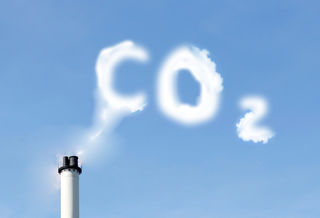
Environment
Deceiving Ourselves About Global Warming?
People overestimate impact of reducing CO2 emissions, new study reports.
Posted May 25, 2019
Many people believe that if we maintain our current level of human-made carbon dioxide (CO2) emissions, and we don’t increase these emissions in the future, a safe equilibrium of CO2 levels can be reached. However, this overlooks the fact that as long as more CO2 is emitted than can be absorbed by the atmosphere, this greenhouse gas will continue to build up. A new paper published in the Journal of Environmental Psychology on May 17, 2019 suggests that cognitive biases impact people’s assessment of greenhouse gases that accumulate in the atmosphere. But a closer examination suggests these results may instead reflect a lack of in-depth scientific background of study participants.
A team of Swedish experimenters led by Mattias Holmgren examined university students’ judgments of the impact of human-generated CO2 emissions on the concentration of CO2 in the atmosphere through a series of three interrelated studies. In each study, participants were given written background on global warming and its impact, ending with a brief discussion of the role of carbon dioxide: “Global warming is influenced by the atmospheric concentration of carbon dioxide (CO2). For example, the higher the increase of the atmospheric concentration of CO2, the faster the average temperature will rise. The atmospheric concentration of carbon dioxide (CO2) is usually reported in ‘parts per million’ (PPM) and the current concentration is around 407 PPM.”
The participants in the first study were asked to read two scenarios about CO2 emissions and to provide estimates of the impact on concentrations of CO2 in the atmosphere for both scenarios. In the first scenario, for five years humankind produces 2 parts per million (PPM) of CO2. In the second scenario, for five years humankind produces 2 PPM, followed by five years of production at 1.4 PPM. What is the impact on the concentration of CO2 in the atmosphere under the two scenarios?
Study participants estimated that in the first scenario, atmospheric concentration of CO2 would increase by about 3 PPM, while in the second scenario, it would decrease by about 1 PPM. The researchers conclude that study participants fell prey to a “negative footprint illusion,” because they assumed that the five years of the more harmful level of CO2 output (5 PPM) could be mitigated to some extent when followed by five years of a less harmful level (1.4 PPM), as evidenced by the participants’ projected decrease in overall CO2 levels in the atmosphere in scenario two.
But this “averaging bias” is inaccurate, the researchers argue, because it is logically impossible for the total production of CO2 over five years at 5 ppm to be less than the total production of CO2 over two five-year periods—one period during which CO2 is produced at a level of 5 ppm, followed by a second period at a lower level. As the researchers summarize their analysis, the negative footprint illusion “is associated with people failing to take into consideration the simple fact that A + B must necessarily be larger than, or equal to, A.”
In their second study, the researchers replicated the first study, but with one difference. They added a third scenario: humankind produces 1.4 PPM of CO2 for a five-year period. Thus, in study two, there are two scenarios in which participants needed to estimate the change in atmospheric concentration of CO2 over only a five-year period, either a low level (1.4 PPM) or a high level (2 PPM). The researchers found that the low level of CO2 over a five-year period was judged to cause no change in atmospheric CO2 concentration, the high level of CO2 over a five-year period was judged to increase CO2 levels by just over 4 PPM, and the mix of high and low levels of CO2 over a ten-year period was judged to cause an intermediate level of increase—less than 2 PPM. Holmgren and his team interpreted these results as additional support for an averaging bias.
In a final study, the second study was replicated, with the only difference being the elimination of the following passage in the instructions for the low level scenario and the low plus high scenario: “… due to implementations for reducing humanity’s environmental impact (e.g., replacing fossil fuels with renewable fuels).” This change was an attempt to avoid using wording that could suggest that low emission level periods can compensate for high emission level periods. The results paralleled those of study two.
What do these results of these three studies mean? Holmgren and colleagues summarize by writing, “We show that a cognitive bias leads people to think that [a] short period of high CO2 emissions, followed by an equally short period of low emissions, contribute less to the total concentration of CO2 in the atmosphere, than a single short period of high emissions alone.”
Another explanation?
But is the negative footprint illusion, based on an averaging bias, really the best explanation for these results? Might the findings instead have been due to confusion when making estimates across different timescales, or simply a lack of knowledge about the chemical processes responsible for the accumulation of CO2 in the atmosphere?

As the researchers note, it’s logically impossible for the total production of CO2 to be less over a ten-year period that contains a five-year period of high-level CO2 production, when compared to the same high level of CO2 production in a period lasting only five years. As long as at least some CO2 is produced during the second five-year time period, even if it’s a lower level, the total production is greater over the ten-year period than over the five-year period. To use the researcher’s comparison, A + B is always greater than A alone.
As the researchers interpret their results, they seem to suggest they expect study participants should have based their responses on the total amount of CO2 produced in each scenario, regardless of whether it was a five-year or ten-year period. But if that’s the case, and if it’s an obvious error of basic arithmetic to conclude that A is less than A + B, then why would participants make this error? Recall that participants rated the total contribution of CO2 to the atmosphere as highest in the five-year period with high levels of CO2 production, lowest in the five-year period with low levels of CO2 production, and intermediate in the ten-year period that consists of five years of high emission levels and five years of low emission levels. The respondents may indeed be averaging across the ten-year period to estimate the overall impact. But why should that be seen as an error?
The mechanisms of CO2 accumulation in the atmosphere are not intuitively obvious. As Holmgren and colleagues note, the stock of CO2 in the atmosphere at any time is affected by both the influx of CO2 created by humans and the outflow of CO2 through natural processes. While people may think that the solution to global warming is to keep CO2 emissions levels at the current level, as long as the input of CO2 into the atmosphere exceeds the outflow, we’ll see an accumulation of CO2.
It’s not surprising that people who have not studied the technical issues of CO2 absorption will not know exactly how many PPM of CO2 can be absorbed by the atmosphere without causing global warming, because this input is offset by the natural outflow of CO2. Nor is it obvious to the uninitiated layperson how the rate of introducing more CO2 into the atmosphere (for example, over five years vs ten years), affects the accumulation of CO2 in the atmosphere. All of this depends on an understanding of chemical mechanisms—which was not provided to the participants in these studies.
Might the participants have been confused by the task, being asked to estimate changes to CO2 levels in the atmosphere based solely on what they were told about how much CO2 was emitted in each condition, when the link between the total amount of CO2 that is emitted and the total amount absorbed by the atmosphere isn’t obvious? As the researchers themselves note, the two are not necessarily equal.
Indeed, one anecdotal suggestion that the task was confusing was noted by the experimenters, who excluded three participants from both study one and study two before analyzing the data, because these participants failed to estimate the low CO2 condition as being a lower contributor to atmospheric levels of CO2 than the high CO2 condition. It’s important to note that participants in the three studies were different. Thus, a total of six participants were eliminated for making ratings that should be obviously incorrect, by the researchers’ evaluation. Given the nature of the experimental task, and the limited information given about the relationship between CO2 emissions and levels of CO2 in the atmosphere, it seems this ranking of impacts wasn’t as obvious as intended.
Having looked more closely at alternative explanations for these findings, let’s return to the researchers’ summary: “We show that a cognitive bias leads people to think that [a] short period of high CO2 emissions, followed by an equally short period of low emissions, contribute less to the total concentration of CO2 in the atmosphere, than a single short period of high emissions alone.” In light of the complex relationship between levels of CO2 emission and the levels of CO2 in the atmosphere, and the fact that the experimental materials did nothing to explain this relationship to study participants, it’s very reasonable to think that the single five-year period of high emissions will have a greater impact. Without knowing more about the chemical mechanisms of CO2 absorption, one might imagine that a period of low levels of CO2 emission would allow time for the atmosphere to absorb higher levels of emissions from the first five-year period. To an atmospheric scientist this may clearly be incorrect, but the study participants had no special background in this topic, and no additional information was provided.
Holmgren and colleagues do emphasize that the results may have been influenced by participants lacking information about the relationship between the total amount of CO2 contained in the atmosphere (the “stock”) and the “flow” of CO2 into the atmosphere or out of it, depending on whether the CO2 emissions are greater or less than the natural outflow of CO2 from the atmosphere. “Unlike previous research on the negative footprint illusion,” they write, “this paper adds on previous research suggesting that people do not have an accurate understanding of the stock-flow relationship of CO2 in the atmosphere.” But when they go on to suggest that the averaging bias may be partly responsible for this, it’s unclear how bias can be attributed when the knowledge required for an unbiased assessment is lacking.
Whatever the final explanation for the results, this triad of studies offers a compelling reminder that we humans are limited in our ability to assess the impact of changing our behavior as we attempt to address climate change. Holmgren and colleagues suggest that the averaging bias may make people more susceptible to accepting policies that bring about emission reductions, even if those reductions are not enough to yield significant changes to the environment. But even when our judgments are not impacted by bias, they are dependent on a sufficiently in-depth understanding of the scientific explanation of global warming. Without at least a basic scientific foundation in climate change, people are justified in being wary of their ability to assess the real environmental impact of their own actions.
References
Holmgren, M., Kabanshi, A., Langeborg, L., Barthel, S., Colding, J., Eriksson, O., Sörqvist, P. (2019). Deceptive sustainability: Cognitive bias in people's judgment of the benefits of CO2 emission cuts. Journal of Environmental Psychology, 64, 48-55. https://doi.org/10.1016/j.jenvp.2019.05.005



